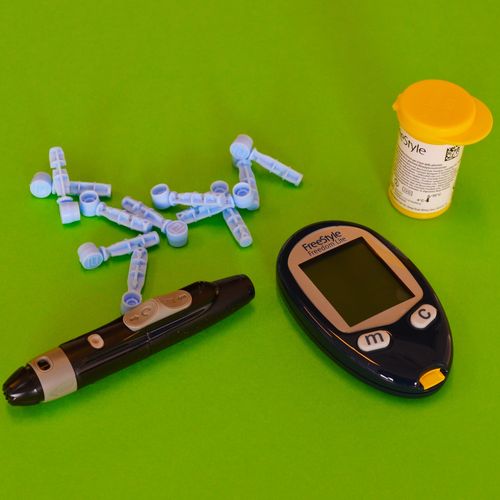Test strips and blood glucose monitors are the traditional way of checking your blood sugar levels. You use test strips to give you an on-the-spot reading of your blood sugar and help you manage your range.
Depending on your personal medical needs, a monitor and test strips might be required for you to manage your diabetes. Our goal here is to give you an overview of what monitors and test strips are, and where you can obtain them.
Blood Glucose Monitors
If you have diabetes and take insulin for treatment, you should already own a blood glucose meter. The standard device will have a lancet for pricking your finger, an easy-to-read digital display, and a strip insertion area.
Blood glucose meters will also be needed if you take medications such as sulphonylurea for your diabetes.
Blood glucose monitors come in a variety of types. You can log your readings on a computer using some meters that have USB connections. You can also get meters that can connect to your smartphone and can calculate insulin to carbohydrate ratios.
Another option is a strip free meter. Essentially, this means that strips are already inserted into the meter, so you do not need to insert them. This meter has a cassette that rotates test strips instead of needing to replace a strip for each use.
The cassette needs to be replaced when it runs out and there are usually 50 strips in each cassette.
In addition to checking your blood glucose levels, you can also check your ketone levels with a blood glucose meter. When treating diabetes with insulin, it is important to know if you have ketones.
How to Get a Blood Glucose Monitor
If you have type 1 diabetes or take medications that can cause hypos, your doctor or nurse will provide you with a free blood glucose meter. Occasionally, a prescription will be given instead. If you have diabetes and you take medications to treat it, you won’t have to pay for prescriptions.
The NHS might not be able to provide you with a blood glucose monitor if your diabetes isn’t being treated with medication that causes hypos. Currently, it is a NICE recommendation that not all people with diabetes should self-monitor their blood sugar. If you decide to self-monitor, you should speak with your healthcare provider.
Blood glucose meters can be found in many different types. Your doctor or nurse may not be able to give you the one you wanted or read about. In any case, they should supply you with a monitor that meets your specific needs for monitoring your blood sugar levels.
Pharmacies and online retailers sell blood glucose meters. Test strips and meters are available in our online shop. Before purchasing your own meter, we recommend you consult your doctor or healthcare advisor.
Your blood glucose monitor has a test strip that you insert. You test your blood sugar level by applying a small drop of blood to the strip.
Where to Get Diabetes Test Strips
If you do not have a prescription, you can buy test strips at any pharmacy, or online.
In most cases, test strips can only be used with one type of meter. Therefore, it is wise to know which strip is compatible with your meter before purchasing. You should also keep this in mind when using your prescription to obtain test strips. Depending on where you live, pharmacies may only have a limited range of meters available and will only prescribe strips for the meters they provide.
Getting test strips on prescription is not always possible for people with Type 2 diabetes. Obtaining test strips on prescription is only possible if your doctor or nurse recommends self-monitoring.
How to Use a Diabetes Test Strip
Unless it comes preinstalled, you should start by inserting the strip into your meter. Then after you’ve pricked your finger, you take your meter and hold the test strip against your blood. Blood sugar levels can be obtained from your meter this way.
Understanding Blood Glucose Ranges
When using test strips and monitors, it’s crucial to understand what your blood glucose readings mean. Here’s a quick guide:
- Fasting (before meals): 4.0 to 7.0 mmol/L
- 2 hours after meals: 5.0 to 10.0 mmol/L
- Before bed: 6.0 to 10.0 mmol/L
Remember, these are general guidelines. Your doctor might set different targets based on your specific health needs, age, and other factors.
If your readings fall outside these ranges, don’t panic. Occasional highs and lows happen. But if you notice a pattern of readings outside your target range, it’s time to chat with your healthcare provider. They might adjust your treatment plan or suggest lifestyle changes.
Keeping a log of your readings can help you spot trends. Many modern meters can sync with smartphone apps, making this task easier. These apps often let you add notes about meals, exercise, and medication, giving you and your doctor a fuller picture of your diabetes management.
Check Your Blood Sugar in Other Ways
Using a blood glucose monitor isn’t the only way to check your blood sugar regularly. Depending on your eligibility, you can also use a flash glucose monitor or a continuous glucose monitor (CGM).
The traditional finger pricking method will still be necessary at times, regardless of whether you use flash or CGM. This is necessary as the results from flash and CGM are both delayed by a small amount.
Photo by Diabetesmagazijn.nl on Unsplash
Zoom Health is a leading UK supplier of Home Health Tests and Earplugs





